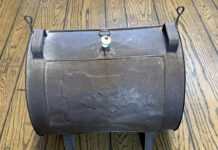Last week I wrote about how badly the corn markets had broken — nearly $3 lower in six weeks or so.
Characteristically, the corn bounced. Now we are poised to guess how high the bounce is.
The magic number this week was $6. If I could pay that for corn, picked up at the farm, some of my large customers would clean up the bins. The problem was, we had done a few bushels at $6, then that price went away. Surely it would come back. The $7 that they had passed on would not, but surely the $6 would.
Check the charts
Now, this seems reasonable, but there is no great way to predict the future. The only fairly good way I know is to look at the charts.
This is so-called “technical analysis.” As I told the $6 customers this week, the charts do not look good. Add to the December futures chart the 30-year seasonal chart Jon Hart from our Pa. office passed on to me, and the future looks even worse.
First, look at the December chart. December now has two charts, since we trade open outcry (pit) trading and electronic trading these days. We used to do the electronic only at night. The electronic seems to have bigger ranges, with the high or low there a little more extreme swings than in the pits.
What I was watching the last few days was the previous high on the chart. That was made July 30 at 6.24 3/4. From there, the break was to 5.04 1/2, a bleak loss of $1.20 1/4 of the overall $2.94 3/4 loss.
On Thursday the 21st, we broke through the old high, to 6.25. Friday we were lower, but Monday the 25th, we hit 6.28 3/4.
Hit the high, then sell
Most interesting to me, as we hit those levels, was that both days we opened strongly, hit the high for the day, then crashed. That is the kind of trading that defines a high.
We basically just confirmed the high, then all the traders were poised to sell it off. This makes a hard ceiling in the market that is hard to break through. In fact, as the end of the day, we were at $6.
Adding to the thinking, we are down over 11 cents overnight, to 5.88 3/4.
The party is over
The 30-year seasonal chart adds to the sense that the party is over.
There is a surprise of sorts there. All year we have been talking about how extreme the year has been and how there has been no predicting what is happening. Surprise!
In one way, this year has been just as we could have expected. The 30-year seasonal chart shows the timing of the market this year was typical of seasonal movement. It is just the range, the price extremes, that have made history.
Not all that abnormal
The normal seasonal movement of price is that the low for the 2008 crop comes during the 2007 crop harvest. Prices tend to rally into May, then rally more sharply on weather and crop concerns until late June or sometimes early July.
Normally, there is then a break until early August, as the weather concerns are relieved. A bounce follows into August, then we trail lower into the harvest and make the low around Oct. 1.
If you look at the December 2008 chart, those are just the things that happened to price. The difference was that we had a nearly $8 high instead of the normal $3 or so.
For example, the low was back on Oct. 8 at 3.86 1/2. The high was June 16 at 7.91 1/2, then June 27 at 7.99 1/4. From there, we broke to 5.62 3/4 on July 23, bounced to $6.24 3/4 on July 30, then made a low of $5.04 1/2 on Aug. 12.
Then came the bounce we were just looking at, to 6.28 3/4.
There are conclusions from this. First, hindsight is 20/20; second, timing is more important than actual prices; and, third, the party is over for this year.












